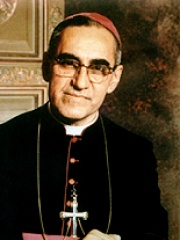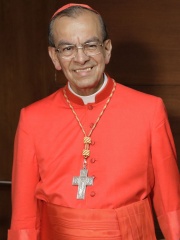

The Most Famous
RELIGIOUS FIGURES from El Salvador
This page contains a list of the greatest Salvadoran Religious Figures. The pantheon dataset contains 3,187 Religious Figures, 2 of which were born in El Salvador. This makes El Salvador the birth place of the 94th most number of Religious Figures behind Palestine, and Estonia.
Top 2
The following people are considered by Pantheon to be the most legendary Salvadoran Religious Figures of all time. This list of famous Salvadoran Religious Figures is sorted by HPI (Historical Popularity Index), a metric that aggregates information on a biography's online popularity.

1. Óscar Romero (1917 - 1980)
With an HPI of 71.28, Óscar Romero is the most famous Salvadoran Religious Figure. His biography has been translated into 53 different languages on wikipedia.
Óscar Arnulfo Romero y Galdámez (15 August 1917 – 24 March 1980) was a prelate of the Catholic Church in El Salvador. He served as Auxiliary Bishop of the Archdiocese of San Salvador, the Titular Bishop of Tambeae, as Bishop of Santiago de María, and finally as the fourth Archbishop of San Salvador. As archbishop, Romero spoke out against social injustice and violence amid the escalating conflict between the military government and left-wing insurgents that led to the Salvadoran Civil War. In 1980, Romero was shot by an assassin while celebrating Mass. Though no one was ever convicted for the crime, investigations by the UN-created Truth Commission for El Salvador concluded that Major Roberto D'Aubuisson, a death squad leader and later founder of the right-wing Nationalist Republican Alliance (ARENA) political party, had ordered the killing. In 1997, Pope John Paul II bestowed upon Romero the title of Servant of God, and a cause for his beatification was opened by the church. The cause stalled but was reopened by Pope Benedict XVI in 2012. Romero was declared a martyr by Pope Francis on 3 February 2015, paving the way for his beatification on 23 May 2015. During Romero's beatification, Pope Francis declared that his "ministry was distinguished by his particular attention to the most poor and marginalized." Pope Francis canonized Romero on 14 October 2018. Seen as a social conservative at the time of his appointment as archbishop in 1977, Romero was deeply affected by the murder of his friend and fellow priest Rutilio Grande and thereafter became an outspoken critic of the military government of El Salvador. Hailed by supporters of liberation theology, Romero's relationship with this theology was debated and initially led to impediments in his beatification process, with both denials and affirmations of Romero adhering to it. According to his biographer Michael E. Lee, since Romero's theological thought and homilies extensively utilized the theme of liberation, and Romero borrowed numerous controversial elements of liberation theology, he "can be seen as an exemplar of liberation theology". Similarly, Peter McLaren also argued that "Archbishop Oscar Arnulfo Romero adopted an outspoken stance in favor of 'liberation theology'". In 2010, the United Nations General Assembly proclaimed 24 March as the "International Day for the Right to the Truth Concerning Gross Human Rights Violations and for the Dignity of Victims" in recognition of Romero's role in defence of human rights. Romero actively denounced violations of the human rights of the most vulnerable people and defended the principles of protecting lives, promoting human dignity and opposing all forms of violence. Archbishop José Luis Escobar Alas, one of Romero's successors as Archbishop of San Salvador, asked Pope Francis to proclaim Romero a Doctor of the Church, which is an acknowledgement from the church that his religious teachings were orthodox and had a significant impact on its philosophy and theology. Latin American church groups often proclaim Romero an unofficial patron saint of the Americas and El Salvador; Catholics in El Salvador often refer to him as San Romero, as well as Monseñor Romero. Outside of Catholicism, Romero is honoured by other Christian denominations, including the Church of England and Anglican Communion, through the Calendar in Common Worship, as well as in at least one Lutheran liturgical calendar. Romero is also one of the ten 20th-century martyrs depicted in statues above the Great West Door of Westminster Abbey in London.

2. Gregorio Rosa Chávez (b. 1942)
With an HPI of 60.10, Gregorio Rosa Chávez is the 2nd most famous Salvadoran Religious Figure. His biography has been translated into 24 different languages.
Gregorio Rosa Chávez (Spanish pronunciation: [ɡɾeˈɣo.ɾjo ˈrosa ˈtʃaβes]; born 3 September 1942) is a Salvadoran Catholic prelate who served as Auxiliary Bishop of San Salvador from 1982 to 2022. He was a close collaborator of St. Óscar Romero. Pope Francis made Rosa a cardinal on 28 June 2017, the first cardinal from El Salvador and a rare instance for any auxiliary bishop; the ordinary of a diocese typically is afforded that distinction when it is granted. As such, in archdiocesan affairs the Archbishop of San Salvador had precedence but Rosa ranked higher in the larger Church structure.
People
Pantheon has 2 people classified as Salvadoran religious figures born between 1917 and 1942. Of these 2, 1 (50.00%) of them are still alive today. The most famous living Salvadoran religious figures include Gregorio Rosa Chávez. The most famous deceased Salvadoran religious figures include Óscar Romero.

